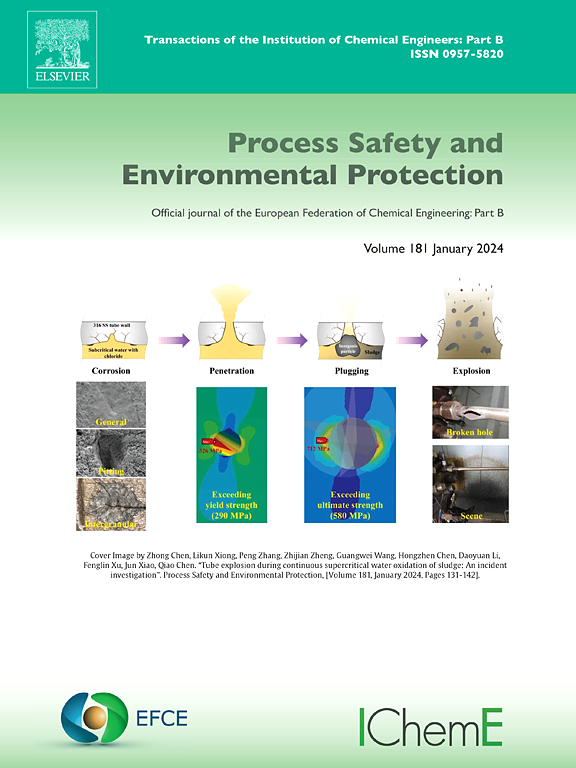Study on the adsorption of common antibiotics in water by cellulose-based adsorbents derived from sugarcane bagasse
IF 6.9
2区 环境科学与生态学
Q1 ENGINEERING, CHEMICAL
引用次数: 0
Abstract
Potassium acetate-modified cellulose biochar (PCB) derived from bagasse cellulose was utilized as an adsorbent. The adsorption performance and mechanism of PCB were evaluated using a typical mixture of antibiotics in simulated river water, including sulfamethoxazole (SMX), sulfadiazine (SMT), ofloxacin (OFL), ciprofloxacin (CIP), chloramphenicol (CAP), and florfenicol (FF). The PCB had a high specific surface area of 1693.22 m2/g. At 298 K, the maximum adsorption capacities of PCB for OFL, CIP, CAP, SMT, SMX, and FF were 158.492, 131.068, 76.391, 62.701, 38.802, and 33.417 mg/g, respectively. The adsorption of the six mixed antibiotics by PCB conforms to the pseudo-second-order kinetics and the Langmuir model. Competitive adsorption occurred among the mixed antibiotics, with OFL and CIP occupying the adsorption sites. The effect of pH on the adsorption capacity is significant. The adsorption mechanisms of typical antibiotics were investigated by integrating quantum chemical theoretical calculations. The contributions of electrostatic interactions, hydrogen bonding, and π-π interactions to the adsorption performance were quantitatively analyzed.
求助全文
约1分钟内获得全文
求助全文
来源期刊

Process Safety and Environmental Protection
环境科学-工程:化工
CiteScore
11.40
自引率
15.40%
发文量
929
审稿时长
8.0 months
期刊介绍:
The Process Safety and Environmental Protection (PSEP) journal is a leading international publication that focuses on the publication of high-quality, original research papers in the field of engineering, specifically those related to the safety of industrial processes and environmental protection. The journal encourages submissions that present new developments in safety and environmental aspects, particularly those that show how research findings can be applied in process engineering design and practice.
PSEP is particularly interested in research that brings fresh perspectives to established engineering principles, identifies unsolved problems, or suggests directions for future research. The journal also values contributions that push the boundaries of traditional engineering and welcomes multidisciplinary papers.
PSEP's articles are abstracted and indexed by a range of databases and services, which helps to ensure that the journal's research is accessible and recognized in the academic and professional communities. These databases include ANTE, Chemical Abstracts, Chemical Hazards in Industry, Current Contents, Elsevier Engineering Information database, Pascal Francis, Web of Science, Scopus, Engineering Information Database EnCompass LIT (Elsevier), and INSPEC. This wide coverage facilitates the dissemination of the journal's content to a global audience interested in process safety and environmental engineering.
 求助内容:
求助内容: 应助结果提醒方式:
应助结果提醒方式:


